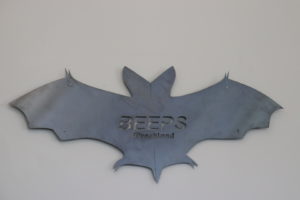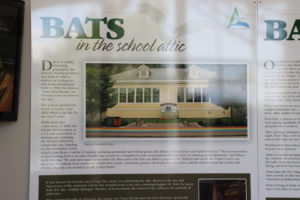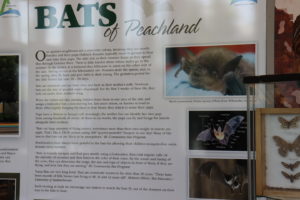Bats
Get to Know our Bats!
In 2002, after a long history of educating Peachland youth, the historic primary school shut its doors and the students moved to the larger Peachland Elementary school. The heritage building sat vacant for nearly a decade and fell into disrepair. The community feared that the building would be torn down and a piece of Peachland’s history lost.
In 2011, a miraculous discovery was made. A maternal bat colony was discovered in the historic primary school, now the Peachland Art Gallery & OurSPACE, and they had been living there for decades. After that discovery, Peachland bats, previously considered a nuisance, became treasured by the community. They are responsible for keeping our beautiful waterfront mosquito free, and the confirmation of the colony save the historic school from being torn down.
These upstairs neighbours are a maternal colony, meaning they are mostly females and their pups (babies). The Historic School attic acts as their summer home as they spend May through October there. In the winter, they hibernate in caves on the other side of the lake to hang out with the dads. In the spring, they fly back to the attic and give birth to their young. The pups learn to fly right here in Peachland!
Despite Peachland’s love for her bats, they tend to carry a bad reputation due to misinformation and fear. Recognizing the need to educate the public on these amazing creatures, the Bat Education and Ecological Protection Society (BEEPS) was formed. They actively promote the protection and preservation of the bats in a number of ways. They educate the public by giving “bat chats”, assist people with inquiries about how to live with bats, and much more.
To learn more about Peachland’s Bats and what BEEPS is doing, check out their website at beepspeachland.com



Bats in The Schoolhouse Attic
Due to a rapidly increasing population, the historic Peachland school was built in 1908 to replace an inadequate one room schoolhouse built in 1898. The beloved “little Schoolhouse” on Brandon Lane survives to this Day.
The School operated for nearly a century until 2002 where it sat idle for the next 7 years.
While there was controversy in 2009 the district of Peachland in a 5-2 vote committed to keeping and restoring the historic school for community use. Funding for the renovation of the school came from a variety of sources, including provincial and federal grants. The district of Peachland and resident donors. “The transformation of this building from a derelict boarded up eyesore to a magnificent new community facility has been an amazing accomplishment” said Mayor Keith Fielding. “We now have space from which the boys and girls club can deliver programs for children and youth, the visitor center can showcase Peachland, local artists can exhibit their work, community groups can access meeting space and the extraordinary bat colony that inhabits the attic can continue to call it their home”
It was known for decades that a large bat colony was inhabiting the attic. However, the size and importance of the maternity colony was revealed from a site visit conducted August 12, 2010, by Aaron Reid, R.P Bio, Wildlife Biologist, Ministry of Environment. He estimated the colony to be upwards of 2000 bats.
“The original thought in 2010 was the colony was Yuma Myotis bats but since that time species ID testing has been done in 2016 and 2018 and it has been determined that the bats occupying the attic in the Peachland Historic School are likely two separate maternity colonies, Little Brown Myotis and Yuma Myotis” Mandy Kellner/biologist/BC Community Bats
Our upstairs neighbors are a maternity colony, meaning they are mostly females and their pups (babies). Females typically roost in groups to bear and raise their pups. The attic acts as their summer home as they spend May through October there. There is little known about where males go in the summer. IN the winter it is believed they hibernate in caves on the other side of the lake. Mating occurs at the hibernation site. Females store the sperm and in the spring they fly back and give birth to their young. The gestation period for little brown bats is 50-60 days.
Bats are mammals and are born alive and feed on their mothers’ milk. Newborn bats are the z=size of an adult males thumbnail. For the first 3 weeks of their life they hold on under their mothers wing. When the babies are tiny, females leave them in one area of the attic and assign a babysitter, a non nursing bat, and last years sisters or aunties tend to them. After a nightly foraging for three to four hours they return to nurse their pups.
Pups have distress or hunger calls. Amazingly the mother bat can identify her pup from hundreds of others. At 3-6 weeks the pups can fly and forage for insects alongside their mothers.
“Bats eat a huge amount of flying insects. Sometimes more than their own weight in insets per night. That’s like a 150lb person eating 600 “quarter pounder” burgers in one day! Many of the insects that bats eat are likely to be mosquitoes” BC Community bat program
Peachlanders have always been grateful to the bats for allowing their children mosquito free swim lessons every summer.
“Bats in Canada navigate and find prey mostly using echolocation. Bats emit regular calls (at the intensity of screams) and then listen to the echo of their voice. By the sound and timing of the echo they can determine the range the size and type of objects in front of them if they are flying and how fast they are moving.” BC community bat program.
Yuma bats are very long lived. They commonly known to be older than 20 years. “There have been records of little brown bats living to 40, 41, and 42 years old.” Melanie Elliot / Bat educator / University of Saskatchewan
Each Evening at dusk we encourage our visitors to watch the bats fly out of the dormers on the way to the lake to hunt





